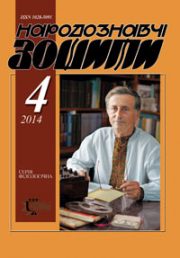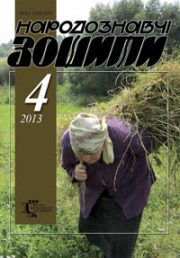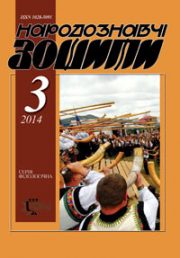The Ethnology Notebooks. 2018, 1 (139), 156–170
UDK39:902.2:728](477.4/.51)»185/196»
DOI https://doi.org/10.15407/nz2018.01.156
Received 14.01.2018
ORCID ID: https://orcid.org/0000-0002-1900-8948
Radovych Roman Bohdanovych, Candidate of Sciences in History, Ph.D, research fellow
in the Department of Historical Ethnology
of the Institute of Ethnology of the National Academy of Sciences of Ukraine.
Svobody Avenue 15, 79000, Lviv, Ukraine.
Abstract. Specific peculiarities of housing construction in the northwest of Eastern Polissia are considered on the basis of field ethnographic materials. The research covers territory of the modern Ripky district of Chernihiv region. Attention is focused on the features of planning, engineering and construction technology, construction materials selection, heating devices, interior features and lighting.
Keywords: Eastern Polissia, building engineering, blockhouse, interior.
REFERENCES
Danyliuk, A.H. (2001). Tradytsijna arkhitektura rehioniv Ukrainy: Polissia. L’viv: Vydavnychyj tsentr LNU im. Iv. Franka.
Domontovich, M. (1865). Materіaly dlja geografіi i statistiki Rossіi sostavlennye oficerami general’nogo shtaba. Chernigovskaja gubernіja. Sankpeterburg: Pechatano v tipografіi F. Persona.
Kosich, M.N. (1906). O postrojkah bѣlorusskago krest’janina Chernigovskoj gub., Mglinskago uizda: sela Rosuhi, derevni Borodinki i Amel’kina hutora. Zhivaja starina. S. Peterburg: Tip. M. P. S. Vyp. 1. P. 74–98.
Kosmina, T. (1999). Poselennia, sadyba, zhytlo. Ukraintsi: istoryko-etnohrafichna monohrafiia: u dvokh knyhakh (Kn. 2). Opishne: Ukrains’ke narodoznavstvo. P. 13–57.
Mironov, V.V., Naulko, V.V., Kosmina, T.V. (1987). Ukraincy. Jetnografija vostochnyh slavjan. Ocherki tradicionnoj kul’tury. Moskva: Nauka. P. 101–146.
Mohyl’chenko, M. (1899). Budivlia na Chernyhivschyni, Hlukhivs’koho povitu u s. Poloshkakh. Materyialy ukrains’ko-rus’koi etnol’ogii. Vydanie etnohrafychnoi komisyi za redaktsyieiu Khv. Vovka (T. 1). L’viv: NTSh. P. 79–95.
Prykhod’ko, M. (1970). Osoblyvosti sil’s’koho zhytla na Polissi. Narodna tvorchist’ ta etnohrafiia. № 6. P. 50–54.
Radovych, R. (1998). Pidbir ta zahotivlia budivel’noi derevyny na Pravoberezhnomu Polissi. Narodoznavchi zoshyty. № 1. P. 54–65.
Radovych, R., Silets’kyj, R. (1996). Stelia ta svolok u tradytsijnomu budivnytstvi polischukiv (konstruktyvno-tekhnolohichnyj ta obriadovyj aspekty). Narodoznavchi zoshyty. № 2. P. 78–92.
Radovych, R. (2014). Polis’ka pich: spetsyfika formuvannia opichchia. Narodoznavchi zoshyty. № 2. P. 270–291.
Radovych, R. (2013). Rozvytok systemy opalennia polis’koho zhytla: sehmentatsiia funktsij pechi. Narodoznavchi zoshyty. № 1. P. 78–87.
Radovych, R. (2012). Polis’kyj «posvit» (tekhnolohichnyj i kul’turno-henetychnyj aspekty). Narodoznavchi zoshyty. № 5. P. 799–817.
Rusov, A.A. (1899). Opіsanie Chernigovskoj gubernіi. Chernigov: Tipografіja Gubernskogo Zemstva. T. 2.
Silets’kyj, R. (2001). Problema typolohii opaliuval’nykh prystroiv starodavn’oho zhytla v Ukraini (konstruktyvno-funktsional’ni osoblyvosti pechi). Zapysky Naukovoho tovarystva imeni Shevchenka. L’viv. Т. ССХLІІ. P. 230–247.
Taranushenko, S. (1995). Zhytlo na Slobozhanschyni. Zapysky Naukovoho tovarystva im. Shevchenka. L’viv. Т. ССХХХ. P. 33–78.
Tokarev, S.A. (1947). Severo-ukrainskaja jekspedicija 1945 g. Institut jetnografii. Kratkie soobshhenija. P. 27–35.
Shafonskij, A. (1851). Chernigovskago namѣstnichestva topograficheskoe opisanіє s kratkim geograficheskim i istoricheskim opisaniem Malyja Rossіi iz chastej koej onoe namѣstnichestvo sostavleno. Kіev: v Univesitetskoj Tipografіi.







